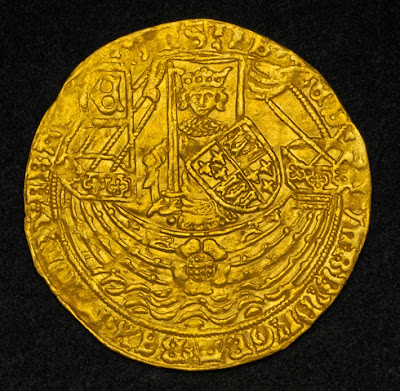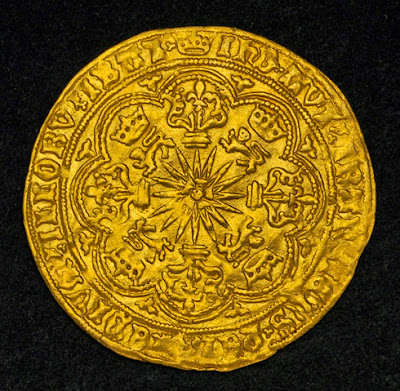 |
| Rose Noble of Edward IV |
 |
| Continental Imitations of the Rose Noble of Edward IV |
Obverse: Crowned and armored King (Edward IV) on ship holding sword and shield of arms, banner with initial (E) to his left.
Comment: Large rose adorning the ship´s hull, flanked by lions and lis symbols. Waves below.
Legend: IB ED WARD DI GRA REX ANGLS FRAN DNS
Reverse: Ornate cross with rose and sun at centre, crowned leopards in angles. All within a polylobe.
Legend: IhD AVT TRANSIENS PER MEDIVM ILLORV IBAT
Mint year: 1583-1591 - Gorinchem City Mint of Mint of Culemborg
Province: Netherlands
References: SCBC 1952, Delmonte, d'Or 825, Friedberg 80a. RR!
Denomination:
Diameter: 37 mm
Weight: 7.57 gram of Pure Gold
As England's European trade steadily increased during the 14th and 15th centuries large quantities of English coins which were known for their quality, good weight and metal fineness ended up in Europe, despite attempts to control their movemen. Gold Nobles were so popular that they were imitated and produced in the Low Countries (now Belgium and Holland), but the style was quite different.
Continental Imitations of the Rose Noble of Edward IV - the large class of rose nobles bearing the name of Edward IV, but of larger module and coarser execution than usual. Their style and fabric, as well as their average weight (about 1x6 grains), stamps them as of foreign manufacture, and they are called "Flemish" because there is a convenient historical explanation for their issue—Edward's seven months' exile in Flanders between October 1470 and April 1471. They are held to be Flemish because they resemble the pieces copied from Henry VI's noble, whose origin is also assumed to be Flemish. The identification of the rose nobles rests solely upon this resemblance, for there is, so far, no documentary evidence in support of an emergency coinage in Flanders—Deschamps de Pas prints no document in his exhaustive studies of the Flemish issues of Charles the Bold which might indicate that the Burgundian mints of Flanders were put at Edward's disposal. Even the fundamental point about the origin of the "Henry" nobles is by no means certain, for there is a suspicion that some of them may have been coined at or near Cologne in the sixteenth century.
In this country the "Flemish" rose nobles of Edward IV have always been regarded (and rightly) as a side-line of English numismatics, but this attitude neglects an important aspect of our numismatic
history—the commercial value of the rose noble abroad, which led to its imitation. Montagu saw this clearly when he postulated a continental issue of rose nobles, based upon Anglo-Flemish trade relations, and continuing to circulate over a very long period. He argued that as some of the Henry nobles (of similar style) were found at Fischenich near Cologne (a hoard buried not earlier than 1624), both currencies could have circulated together during the sixteenth century. Other hoards support this contention, for out of the large number containing English coins there are about half a dozen in which Henry nobles and Edward rose nobles occur either together or separately. In that of Amersfoort, buried about 1560, both currencies were represented, together with Burgundian nobles of Philip the Fair, while at Joncret in Hainaut, in a hoard deposited about 1575-6,7 there were six rose nobles and no Henry nobles.
Several other hoards show a mixture of Edward rose nobles (often accompanied by English angels) and the Dutch provincial rose nobles, struck a few years later (1575-89). At Talmont, in western France, a single Henry noble was associated with three rose nobles, while in an unnamed Dutch find dating from c. 1580-90, only rose nobles were present, again mixed with Dutch issues. From the evidence of these hoards it can be assumed that the English rose noble enjoyed a widespread popularity in France and the Netherlands. It might also be argued that the popularity of the "Henry" noble had to some extent declined, but it is unsafe to generalize in this instance because the investigators of continental hoards have invariably failed to distinguish copies from their originals, and so it is impossible to estimate their comparative frequency. The distribution of the hoards does tell us one thing: the Henry and rose noble currencies are very likely to be Flemish or Dutch in origin, for the majority of the hoards in which they occur are from the Low Countries. The only comparable finds in England that I know of are those at Bisham Abbey (Berks.), where there was one Henry VI noble and six rose nobles, none of which can be proved to be foreign imitations, and at St. Albans, where there were twenty-two rose nobles, none of them copies, and no Henry nobles. Rose nobles and Henry nobles (whether true or imitation) are more common in Scottish hoards, as one might expect from the close relations between that country and France.
Confirmation of the popularity of the Henry and Edward coinage during the sixteenth century is provided by the numerous placards issued in the Netherlands, France, and Scotland, especially towards the end of the century.
Like the foreign sterlings of an earlier period, imitations of the English gold noble were a result of the continual illegal export of coin from England in the fourteenth century.
In spite of the efforts of Edward III and Richard II to attract bullion to the mint, quantities of gold nobles were exported and sold at a profit abroad to be recoined. The Dukes of Burgundy, whose newly acquired Flemish dominions lay nearest to England, did not scruple to coin nobles on the English standard, but of less intrinsic worth. These pests, arriving from the already flourishing trade-centre of Calais, caused great distress in England, until they were driven out of currency by Henry IV's reduction in the weight of his own gold coins in 1412. The harm had been done, however, and there is evidence that a coinage of imitations (other than the official one of the Burgundian Dukes) was growing up abroad. This must have caused some inconvenience in the Burgundian dominions as well as in England, for in October 1433 Philippe le Bon issued an Ordonnance referring to the imitation of deniers d'or "emprainte et fourme des deniers de nostredit Seigneur, ou assez semblables a iceulx" (sic) by neighbouring countries.1 The term denier d'or is always used to describe the noble.
A few years before (in 1423), a money-changer of Malines, named Clais Warin, had been arrested for receiving "monnaies fausses contrefaites et defendus"2 (sic). It is to this period that we must assign the first of the "Henry" nobles, copied from the Annulet issue of Henry VI. Evidently the English noble had become so popular as a commercial currency3 that merchants (or feudal rulers) had found it expedient to issue private and presumably illegal coins.
It is certain that these copies enjoyed a limited circulation in England, for one of them was present in the Horsted Keynes find buried about 1405. When Edward iV remodelled his coinage in 1465 he found it expedient to strike a new denomination in the style of the old noble which had become so popular abroad. The result was the rose noble of higher value and weight, a coin even more popular than its predecessor,
and eventually one of the main currencies of northern Europe. In these circumstances it is not surprising to find that it too was extensively imitated.
A definition of this type of imitation was given by Serrure in 1847, when he described the coins as contrefagons (counterfeits). He further distinguished between those bearing the name and titles of their issuer, whether official or otherwise (e.g. the rose nobles of Holland, Zeeland, Overyssel, &c., as well as nobles of Ghent) and those indistinguishable from their prototype, but not seriously under weight.6 Both classes are represented amongst the rose nobles to be described. Research by continental numismatists, amongst them Verkade, Serrure, and Schulman, has established that many contrefagons of English gold coins (angels, rose nobles, and a few sovereigns) were issued either semi-officially, as in the case of some Friesland coins, or privately and without sanction by municipal authorities, e.g. at Gorinchem in Holland. The issue of these pieces coincides with the beginning of the Dutch wars of Independence and the formation in 1575 of the United Provinces. In view of the close trade connexions between England and the Netherlands, and the influx of English volunteers into the Dutch provinces, both of which contributed to the desire for a new coinage of English style, this is a subject which directly concerns English numismatics.